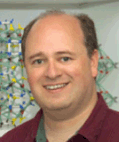Professor Richard Robson FAA
Brendan F. Abrahams A , Stuart R. Batten B and Deanna M. D’Alessandro C DA School of Chemistry, The University of Melbourne, Melbourne, Vic. 3010, Australia.
B School of Chemistry, Monash University, Melbourne, Vic. 3800, Australia.
C School of Chemistry, The University of Sydney, Sydney, NSW 2006, Australia.
D Corresponding author. Email: deanna.dalessandro@sydney.edu.au

Brendan F. Abrahams received his B.Sc. (1985) and Ph.D. (1989) degrees from The University of Melbourne where he is currently an Associate Professor in the School of Chemistry. He has been mentored by and has collaborated with Richard Robson since he completed his Ph.D. and continues to enjoy sharing a research group that involves many joint students. |

Stuart R. Batten received his B.Sc. (1991) and Ph.D. (1996) degrees from The University of Melbourne with Richard Robson and Bernard Hoskins, and is currently a Professor in the School of Chemistry at Monash University. His research interests include inorganic chemistry, crystal engineering, coordination polymers, and supramolecular chemistry, and are detailed in more than 300 publications and one book (Coordination Polymers: Design, Analysis and Application). Stuart is a leading authority on the topology of crystalline networks, particularly entangled nets, and he created a widely adopted nomenclature for describing the topology of that interpenetration. |

Deanna M. D’Alessandro received her B.Sc. (2000) and Ph.D. (2006) degrees from James Cook University under the supervision of Em/Prof. Richard Keene, followed by postdoctoral research (2007–9) with Prof. Jeff Long at the University of California, Berkeley. In 2011, Deanna started her independent research at the University of Sydney where her group works on fundamental and applied aspects of electroactive coordination framework materials. She is currently an Associate Professor and has enjoyed working with Richard Robson since 2015 as part of a joint ARC Discovery grant which they shared with Brendan Abrahams. |
Australian Journal of Chemistry 72(10) 729-730 https://doi.org/10.1071/CHv72n10_FO
Published: 17 October 2019
Richard Robson grew up in a small village in Yorkshire before attending the University of Oxford where he undertook B.A. and D.Phil. degrees (1955–62) (Fig. 1). Following post-doctoral stints at California Institute of Technology and Stanford University (with Professor Henry Taube), he arrived, by cargo ship, in Australia in 1966 and commenced an academic position within the Department of Inorganic Chemistry at the University of Melbourne. In the 60s, 70s and 80s, Robson’s research largely focussed on the design and synthesis of binucleating and tetranucleating ligands with the aim of bringing metal centres into close proximity. The third paper in this series is still in the all-time top 10 cited papers in the Australian Journal of Chemistry.[1] These ligands are now known in the scientific literature as Robson-type ligands.
In the 1970s, Robson was assigned the task of constructing ball-and-stick models of simple inorganic solids such as sodium chloride, caesium chloride, rutile, zinc blende, and wurtzite for use in undergraduate chemistry lectures.† In the design of these models, he became aware upon drilling holes in wooden balls at geometrically appropriate positions that the spheres were ‘invested with information’ which would allow the intended structure to be produced. Although the inorganic solids on which the models were based are dense, it occurred to Robson that it may be possible to generate open network materials with a topology matching that of the models by substituting metal centres or multi-connecting ligands for spheres and linking them by molecular rods.
In 1990, Robson and his long-term collaborator, crystallographer Bernard Hoskins, published a landmark paper in which they outlined a set of principles for the rational generation of crystalline framework materials. Following this pioneering work by Robson, the area of coordination polymers, commonly referred to as ‘metal–organic frameworks’, has been the focus of intense scientific interest around the globe.
This special issue of the Australian Journal of Chemistry collects contributions from colleagues around the world that highlight several areas to which Robson has made seminal contributions. Brooker et al.[2] report on the chemistry of manganese Schiff-base macrocycles, Donnelly et al.[3] report the use of thiosemicarbazone ligands to give copper complexes with applications in PET imaging of Alzheimer’s disease, and Gass et al.[4] use derivatives of yet another class of molecules well studied by Robson – in this case the TCNQF4 radical which acts as a counterion of an iron complex of the radical ligand.
Robson’s contributions in the area of encoding ligands and metals with geometric information that lead to programmed coordination complex assemblies, from Robson macrocycles through to metallosupramolecular cages, are reflected in the contributions of Lindoy and Li,[5] and of Keene et al.[6] The former review recent discrete polyhedral metallocages, while the latter report discrete dinuclear helicates and mesocates.
The bulk of the papers in this issue, however, are unsurprisingly from the field of coordination polymers and metal–organic frameworks (MOFs). Trigonal ligands feature in the papers of McKenzie et al.[7] who report a coordination polymer that displays reversible chemisorption of ammonia; Lang et al.[8] who report six new coordination polymers of a large tripyridyl ligand; and Telfer et al.[9] who report chiral (10,3)-a nets formed by zinc coordination polymers of triazatruxene derivatives. The lanthanoid chloranilate coordination polymers reported by Hua et al.[10] follow earlier work from Robson on this family of materials. Block, Doonan and Sumby[11] report the effect of metal coordination sphere on the porosity of 2D coordination polymers, while Kempe et al.[12] use MOFs as supports for photocatalysts. There are three papers which look at modifying existing MOFs. Richardson et al.[13] functionalise the IRMOF-9 family with nitro groups; Janiak et al.[14] add halogen functionality to MIL-53-Fum and report enhanced gas sorption; and Cohen et al.[15] use crystallisation modifiers to vary the particle size and morphology of UiO-66. Finally, while they do not report coordination polymers, Biradha and Das[16] report the crystal engineering of co-crystals of a series of dipyridyl molecules with various polycarboxylates and resorcinol derivatives.
As we reflect on Robson’s enormous contributions to chemistry over the past five decades, his research continues to inspire new discoveries, including those described herein from collaborators and colleagues. There is no doubt that his enduring influence on coordination chemistry and, in particular, his pioneering contributions to coordination polymers will continue to engage new generations of scientists in this colourful, elegant, and important field.
References
[1] N. H. Pilkington, R. Robson, Aust. J. Chem. 1970, 23, 2225.[2] R. K. Wilson, S. Dhers, S. Sproules, E. J. L. McInnes, S. Brooker, Aust. J. Chem. 2019, 72, 805.
| Crossref | GoogleScholarGoogle Scholar |
[3] L. E. McInnes, A. Noor, P. D. Roselt, C. A. McLean, J. M. White, P. S. Donnelly, Aust. J. Chem. 2019, 72, 827.
| Crossref | GoogleScholarGoogle Scholar |
[4] I. A. Gass, J. Lu, R. Ojha, M. Asadi, D. W. Lupton, B. L. Geoghegan, B. Moubaraki, L. L. Martin, A. M. Bond, K. S. Murray, Aust. J. Chem. 2019, 72, 769.
| Crossref | GoogleScholarGoogle Scholar |
[5] F. Li, L. F. Lindoy, Aust. J. Chem. 2019, 72, 731.
| Crossref | GoogleScholarGoogle Scholar |
[6] K. L. Flint, J. G. Collins, S. J. Bradley, T. A. Smith, C. J. Sumby, F. R. Keene, Aust. J. Chem. 2019, 72, 762.
| Crossref | GoogleScholarGoogle Scholar |
[7] C. Wegeberg, D. Nielsen, S. Mossin, B. F. Abrahams, V. McKee, C. J. McKenzie, Aust. J. Chem. 2019, 72, 817.
| Crossref | GoogleScholarGoogle Scholar |
[8] C. Cao, T.-Y. Gu, J.-G. Zhang, M. Dai, C.-Y. Ni, Z.-G. Yao, J.-P. Lang, Aust. J. Chem. 2019, 72, 751.
| Crossref | GoogleScholarGoogle Scholar |
[9] A. Alkas, S. G. Telfer, Aust. J. Chem. 2019, 72, 786.
| Crossref | GoogleScholarGoogle Scholar |
[10] C. Hua, H. M. Tay, Q. He, T. D. Harris, Aust. J. Chem. 2019, 72, 778.
| Crossref | GoogleScholarGoogle Scholar |
[11] W. M. Bloch, C. J. Doonan, C. J. Sumby, Aust. J. Chem. 2019, 72, 797.
| Crossref | GoogleScholarGoogle Scholar |
[12] D. Tilgner, M. Klarner, S. Hammon, M. Friedrich, A. Verch, N. de Jonge, S. Kümmel, R. Kempe, Aust. J. Chem. 2019, 72, 842.
| Crossref | GoogleScholarGoogle Scholar |
[13] L. Conte, T.-Y. Zhou, O. T. Qazvini, L. Liu, D. R. Turner, S. G. Telfer, C. Richardson, Aust. J. Chem. 2019, 72, 811.
| Crossref | GoogleScholarGoogle Scholar |
[14] T. J. Matemb Ma Ntep, W. Wu, H. Breitzke, C. Schlüsener, B. Moll, L. Schmolke, G. Buntkowsky, C. Janiak, Aust. J. Chem. 2019, 72, 835.
| Crossref | GoogleScholarGoogle Scholar |
[15] K. C. Bentz, S. Ayala, M. Kalaj, S. M. Cohen, Aust. J. Chem. 2019, 72, 848.
| Crossref | GoogleScholarGoogle Scholar |
[16] D. Das, K. Biradha, Aust. J. Chem. 2019, 72, 742.
| Crossref | GoogleScholarGoogle Scholar |
† The ball and stick models designed by Robson are still used today in undergraduate chemistry classes at the University of Melbourne.



